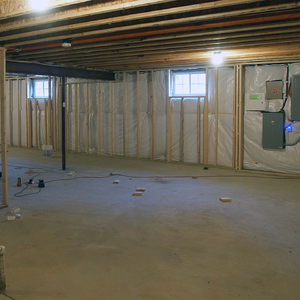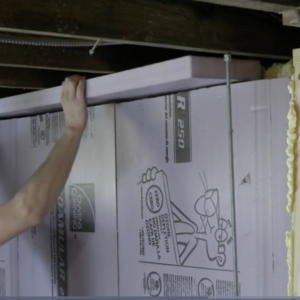
A GBA reader named Steeplechase is tackling the details for a house he’s about to start, and he’s hit the pause button while considering the insulation for a conditioned basement.
His guide is the new Pretty Good House book. On p. 98, the authors recommend the exterior of the foundation wall be insulated with expanded polystyrene foam (EPS) and then waterproofed. On the inside, the wall is sealed with a vapor retarder. Then comes a 2×4 wall insulated with dense-packed cellulose, a variable permeance membrane and, finally, drywall.
“I’m impressed with everything but have recently come up against a question,” Steeplechase writes in this recent Q&A post. “A discussion with another professional recently made me wonder about letting the concrete dry to the inside with all the insulation on the exterior.”
Steeplechase continues: “Typically I like the idea of keeping the concrete on the outside of the vapor control layer, especially with the detail found in the PGH book, in which any inward moisture drive would just hit the back of the Stego wrap.”
But his fellow building pro suggests that the concrete should be allowed to dry to the interior—for a number of years.
What’s the best way of handling this important detail? That’s the topic for this Q&A Spotlight.
Keep the moisture out
Allowing the concrete to dry to the interior is a non-starter for DC_Contrarian.
“Concrete doesn’t need to dry, and you don’t want whatever moisture is in it to enter your house,” he says. “In basements in particular, the whole game is keeping moisture out.”
Is cellulose a good idea?
Thinking that new concrete would need years to dry seems silly to 5Stud, but it does take time, and the idea of using cellulose insulation…
Weekly Newsletter
Get building science and energy efficiency advice, plus special offers, in your inbox.

This article is only available to GBA Prime Members
Sign up for a free trial and get instant access to this article as well as GBA’s complete library of premium articles and construction details.
Start Free TrialAlready a member? Log in














3 Comments
Two things:
1. What is the difference between a damp proofing application and a water proofing application in principle and in practice? I commonly see butyl products applied up to grade level to the exterior of basement walls of new homes near me (DC suburbs).
2. If waterproofing is applied to the outside of the concrete, wouldn't this imply that water could not escape the exterior side of the concrete regardless of whether the insulation was inside or outside the wall? If that's the case, why wouldn't some insulation that isn't negatively affected by moisture be prescribed for an interior application?
Damp-proofing is the minimum required by code. It's usually an asphalt emulsion, meaning asphalt suspended in water. In theory it might be waterproof but in practice it goes on in a thin layer and usually has some areas where it doesn't stick, such as recesses (or "rat's nests") in the concrete. It is brittle when dry so if the concrete cracks, the damp-proofing does no good, and it can be abraded during backfilling.
Waterproofing is usually a rubberized, elastomeric membrane that is rolled or sprayed onto the foundation. It's thick, covers small gaps and cracks and can generally withstand more damage and more water pressure than damp-proofing.
Either product class can be further protected with a dimple mat or membrane that creates a drainage plane directly outside the foundation wall. Some professionals consider damp-proofing and a dimple mat to be waterproof, if the footing drains lead directly to open air.
More info here: https://www.greenbuildingadvisor.com/article/dampproofing-and-waterproofing-foundation-walls
“[Deleted]”
Log in or become a member to post a comment.
Sign up Log in